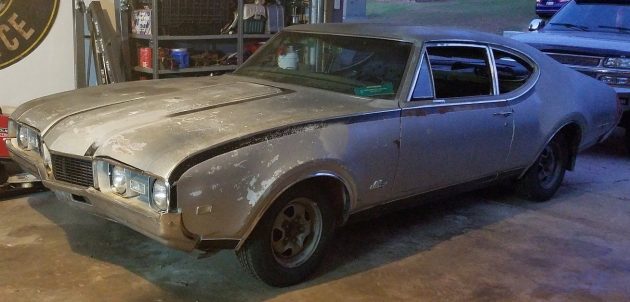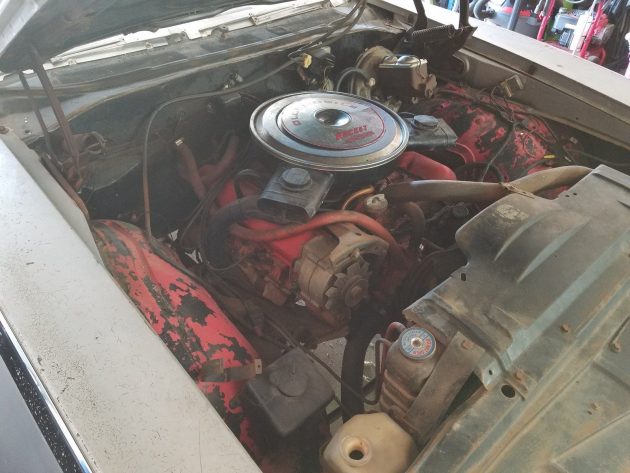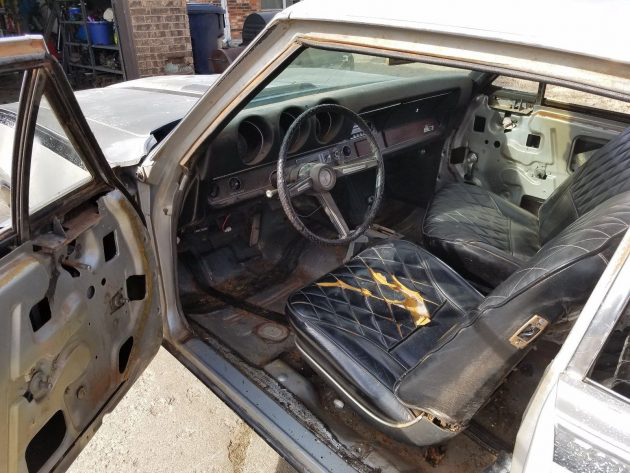The allure of post coupes has always been a draw for me in the collector-car market; their appearance screams sleeper, drawing in an unsuspecting driver in a hot muscle car who thinks he’s got the stoplight race in the bag. Then the light changes green, and he’s choking on tire smoke and dust as you leave him with the sunset and the taillights of your car in the distance as his only view of your car. When you combine a lightweight post coupe with a big-inch high performance drivetrain, you have the perfect storm. This 1968 Hurst/Olds is a great example of the statement above, and is one of 56 two-door post coupes built for 1968. Find it here on eBay in Yukon, Oklahoma, with no bids.
After successfully installing Hurst products in its 442, Oldsmobile collaborated with Hurst Performance (out of Warminster, PA, about a forty minute drive from my home base) to build the ultimate supercar: the Hurst/Olds. After being denied its own F-body model, Oldsmobile reach out to George Hurst (head and founder of Hurst Performance) to build a car perfect for a young car fan base. Hurst, who at the time was trying to persuade Pontiac to sell him a fleet of Firebird 400s to modify (consisting of a swap from the 400 to the 428 and swapping in other performance goodies), was steered towards Oldsmobile by GM’s executives. GM thought that Oldsmobile would be a better base for Hurst’s supercar project, which would attract younger buyers and help sales increase. After the proposal was redirected, Hurst turned the project over to Jack “Doc” Watson, who built a prototype with the necessary and desired modifications. The project stalled, however, until mid-April 1968, more than a month after Watson left Hurst. Finally, after approval from GM to build 500 cars (the biggest snag of the project was the approval of fitting the cars with Olds’ then-new 455 V8), Hurst had 40 days to complete the Hurst/Olds project. After hiring back Watson as a consultant, Hurst worked non-stop to complete the project, abandoning their desired hidden headlamps and adjustable spoiler, and changing the color from Firefrost Gold Metallic with black stripes to Peruvian Silver with black stripes (there was a problem matching the gold to GM’s colors). Despite fears of cars being unsold, GM received 2,600 orders in a matter of days from promotional materials being distributed to dealer zone managers. After 11 cars were ordered from a Lansing, Michigan dealer alone, production was ramped up to 515 cars: 56 pillared Sport Coupes, and 459 Holiday Coupes (hardtops in Oldsmobile-speak), all of which started on the assembly line as 442s.
This 1968 Hurst/Olds is a Post Coupe car, and was the lightest and most rigid car of the 442 lineup. According to the seller, the front clip and windshield are currently removed to get a better view of the car and how solid it really is. The original owner (who is still alive, and whose contact information is available from the seller) bought the car new in 1968 to race, and he did so for the next two years until he sold it to the second owner in 1970. The second owner drove the car to high school after he purchased it, driving the car until 1976, when the car was subsequently put into storage from 1976 until last year (unfortunately, the seller does not provide pictures of the car in its found state and location in his listing, so I would ask the seller if he has pictures of the car of when and where it was found). The exterior is obviously not perfect, but looks to mostly original and overall solid. I would consider leaving the exterior as-is, which would look a lot cooler than it would restored.
This Hurst/Olds is a W45 non-air car, which used a 455 short block with a cast-iron intake manifold with a 750 cfm Quadrajet 4-barrel carburetor from the W31 (Ram-Rod) package. The original block was destroyed in a race from Amarillo to Dallas, so a dealer-replacement block is currently in the car. The correct (and I’m assuming original) D-port heads, intake, carb, distributor, water pump, pulleys and alternator are fitted to the engine. Rated at 390 horsepower and 500 lb-ft of torque, only Mopar’s 426 Hemi made more horsepower at 425, but even the Hemi’s torque was short of the Hurst/Olds’ torque rating. Backed by a TH-400 three-speed automatic (no manual transmissions were available with the Hurst/Olds), a Hurst/Olds hardtop could run a 13.77 @ 103.91mph quarter-mile bone stock, and I’m sure a Post Coupe could shave a few-hundredths of a second off of that. The seller makes no mention of whether or not the motor runs, so I would inspect the drivetrain top and bottom and make sure everything is in working order. Otherwise, like the exterior of the car, I would leave the cosmetics of the drivetrain and the engine bay as-is.
At some point, the second owner (who is now passed away) changed the interior from stock to the diamond-tuck you see today. Though the stock interior is nice, the diamond-tuck looks cool in a period kind of way. The floorpans look like they could use some attention, and the interior (with the exception of the seats, dash and gauges, steering wheel, and shifter) was removed by the seller to begin a restoration. I’ve never seen a vinyl wrapped steering wheel in a Hurst/Olds (most seem to have a three-spoke wood wheel), which makes me wonder if the wheel is original or if it was redone at some point. The dash and dash face appear to be in good shape, and the original Dual-Gate shifter appears to be still installed (though most likely it needs to be restored). I would restore the interior back to stock at some point, but for now I would show the car as-is, including the interior the way it is now (completely installed, of course). Overall, this car may be the holy grail of non-W30 Oldsmobiles, and would be right at home in the Barn Finds section of the Muscle Car and Corvette Nationals outside of Chicago in November. I would leave the cosmetics alone, get the car running, and show this car at all the major GM and muscle car shows. What would you do with this rare first-year Hurst/Olds?





would get it to running order and drive this beast as is!!! cant believe no other posts?? but the Plymouth Champ has 17 comments.
When this rare machine first came out, it was just about the fastest muscle car ever built. I believe it always stayed in the top 5 fastest muscle cars ever built. The cars ran low to mid 13s stock and one magazine ran a stock H/O with only slicks and it ran 12.90s. I’m sure many of you remember reading about that test as it was a very big deal. I once had a 68 H/O non air car and a 70 Rallye 350, the one that was all yellow including the bumpers. Both cars needed to be restored. I paid 3500 for the H/O which I thought was alot at the time and I recall paying only 1000 for the Rallye 350. Great cars. I traded them some time ago for a beautiful 37 Packard Super 8 which I still have today. I love the Packard, however, I wonder now that the value in those Oldsmobiles has climbed, if I made the right move.
I also had a 2 door post w45. Non AC. I had the record at Amarillo Texas E pure stock automatic. 5 meets never lost. I did loose on the street to A Dodge Charger RT 440, a 70 Buick GSX and the rest were in my rear view mirror. My father bought a 68; 2 69s Hurst Olds and the very first Pontiac Grand Prix Hurst SSJ!! He had an eye for cars.
The auction has been pulled.
Back in the late ’80s I bought a collection which included a ’68 all original Hurst Olds 442 hardtop, 34k mi.
Of the many cars I had when I was a serious collector, that would be the one I would want back.
If memory serves, it was the previous Illinois State F/stock automatic champion, something like 12.74.
If anybody has any better memory of that, let me know.
If I could post the photo here, you would appreciate it more, as the car was a real jewel.
cool rare car, I love the exterior but a stock interior would be better.
Has this car been sold? I’m interested!